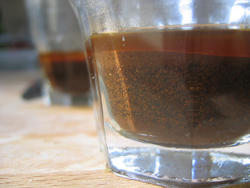

After the coffee has cooled sufficiently take some coffee into the spoon and slurp the coffee strongly to aspirate it over the entire tongue. It is important to aspirate strongly since you are trying to cover the entire tongue evenly. Aspirating strongly will also cause tiny droplets of coffee to be distributed into the throat and into the nasal passage. The nose can act as another powerful tasting tool. Most of the flavor observed in a coffee is a result of aromatic compounds present in the coffee. This effect can be demonstrated by plugging your nose while drinking coffee. While the nasal passage is blocked, the coffee will likely taste similar to instant coffee due to its lack of aroma. When the nasal passage is opened, a full rainbow of flavors will immediately become evident.
After each coffee taste test, write down your observations of coffee taste, acidity, aftertaste, and body. Move to the next cup and try to compare the different cups. As the coffee in each cup cools, it is often possible to detect new flavors. Therefore, it is important to cup a coffee when it is both warm and when it has cooled to just above room temperature. The best coffees will have positive characteristics at both ranges of temperature.
If you are cupping more than a couple cups of coffee, it is advisable to spit out the coffee after evaluation. When cupping several coffees it is possible to have too much caffeine, which can adversely alter your cupping ability.


- Acidity - A basic taste characterised by the solution of an organic acid. A desirable sharp and pleasing taste particularly strong with certain origins as opposed to an over-fermented sour taste.
- Bitterness - A primary taste characterised by the solution of caffeine, quinine and certain other alkaloids. This taste is considered desirable up to a certain level and is affected by the degree of roast brewing procedures.
- Sweetness - This is a basic taste descriptor characterised by solutions of sucrose or fructose which are commonly associated with sweet aroma descriptors such as fruity, chocolate and caramel. It is generally used for describing coffees which are free from off-flavours.
- Saltiness - A primary taste characterised by a solution of sodium chloride or other salts.
- Sourness - This basic taste descriptor refers to an excessively sharp, biting and unpleasant flavour (such as vinegar or acetic acid). It is sometimes associated with the aroma of fermented coffee. Tasters should be cautious not to confuse this term with acidity which is generally considered a pleasant and desirable taste in coffee.

- Body - This attribute descriptor is used to describe the physical properties of the beverage. A strong but pleasant full mouthfeel characteristic as opposed to being thin. To an amateur coffee taster, body can be compared to drinking milk. A heavy body is comparable to whole milk while a light body can be comparable to skim milk.
- Astringency - The astringent attribute is characteristic of an after-taste sensation consistent with a dry feeling in the mouth, undesirable in coffee.
Information Source: Coffee Research and Wikipedia and Image Source: Barismo
Cupping
Aroma Analysis | Aroma Types | Taste Wheel
Cupping Overview
Roasting
Roasting | Drying Process | Flavor Characteristics of Drying Process
Sorting |
Polishing and Aging | Decaffeination Processes

















































